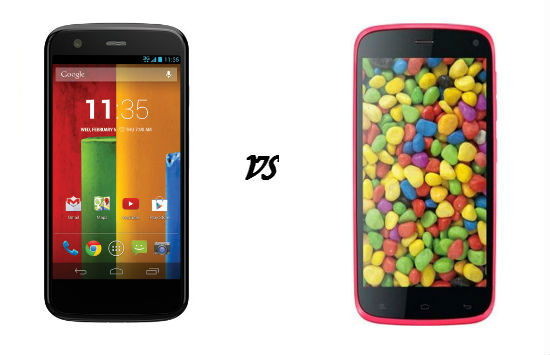Display and Processor
The display unit of the Moto G is a 4.5 inch one which has a resolution of 1280 X 720 pixels. It translates into a pixel density of 326 ppi and is layered Corning Gorilla Glass 3 protection on top as well. The Gionee Elife E3 on the other hand has a larger 4.7 inch IPS LCD display with a resolution of 1280×720 pixels and it should translate into an increased pixel density of roughly 312 ppi. However, there is no Gorilla Glass protection on the handset. Consequently, though the latter comes with a larger screen but doesn’t match the bright and wonderful IPS LCD panel in Moto G. Ticking inside the Moto G is a 1.2 GHz Quad Core Snapdragon 400 processor coupled with a 1 GB RAM. The Gionee Elife E3 gets a 1.2 GHz quad-core MediaTek MTK6589 processor that is again paired with 1 GB of RAM for decent performance. A better RAM in both the devices is capable of decent multi-tasking. Moto G will serve better in this department as well with enhanced processor and better GPS connectivity.
Camera and Internal Storage
The Moto G brings only its 5 MP primary snapper with LED flash to the table. Well, there is no front-facing camera onboard. Going by the competition, the Gionee Elife E3 arrives with higher megapixels in its 8 MP primary snapper with auto-focus and LED Flash. Both Camera’s can record 720p Videos and neither is a very good performer. However, low light performance of Moto G is better. Again, in term of storage the Gionee phone shines bright with 16 GB of internal storage space that is good enough to store the necessary content without depending on the external memory. But, the handset also includes a micro SD card slot that supports up to 32 GB of expandable storage. In comparison, the Moto g smartphone includes only 8 GB/ 16 GB internal storage, and you will have to remain content with that, their is no option for improving storage.
Battery and Features
The battery unit giving the Moto G power to run is a 2050 mAh one, whereas the one in a 1,800 mAh battery powers the Gionee Elife E3. Both these batteries are capable enough of pumping in moderate backup under mixed usage. Battery backup is one of the highlights of Moto G and its will last longer. Moto G runs on latest Android 4.4 KitKat which is quite smooth as compared to the dated Android 4.2 Jelly Bean in the Gionee Elife E3. Moreover, the Motorola phone has started receiving the Android 4.4.4 KitKat update lately and it also gets some exclusive apps making it a better offering in terms of software.
Key Specs
Price and Conclusion
Both of these devices have similar specifications and having spent some quality time with both of the above, we liked user experience on Moto G slightly better than that on Elife E3. Moto G also has good chances of getting Android L update and that alone makes it a winner. Gionee Elife E3 is now slightly dated, but still packs enough hardware and more than decent built quality to pacify basic users.
